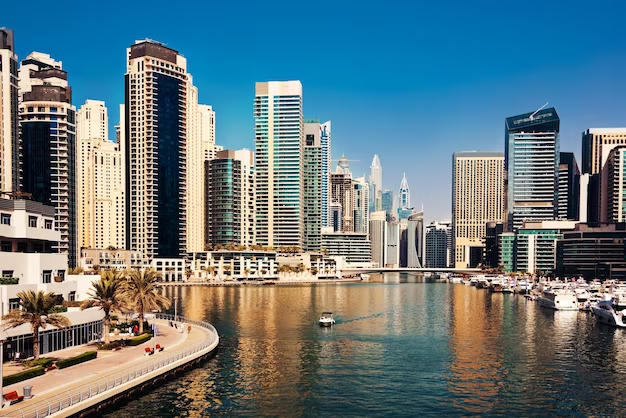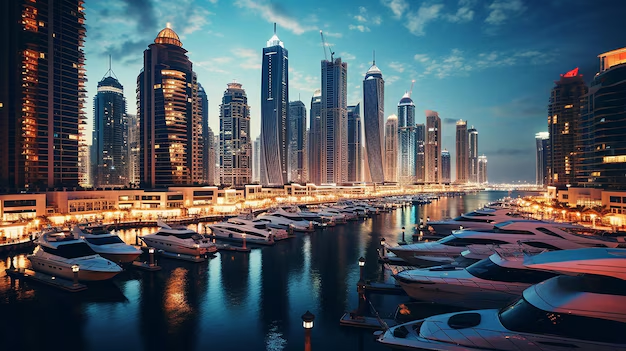Embark on a journey through the stunning cityscape of Dubai, where architectural marvels rise above the desert landscape, redefining the very essence of modern design. These cutting-edge skyscrapers not only reshape the skyline but also push the boundaries of what is possible in the world of architecture. From the iconic Burj Khalifa to the luxurious Burj Al Arab, each building stands as a testament to Dubai’s ambition and innovation in the realm of architectural excellence. As you explore these towering structures, you’ll witness a city that is constantly evolving, setting new standards for design and engineering that captivate the world’s attention.
The Rise of Dubai’s Skyscrapers
Dubai’s skyline has undergone a remarkable transformation over the years, propelled by the emergence of striking skyscrapers that symbolize the city’s ambition and prosperity. Spearheaded by architectural marvels like the Burj Khalifa and the Burj Al Arab, these towering structures stand as iconic landmarks, reflecting Dubai’s relentless pursuit of innovation and excellence. Beginning in the late 1990s, a construction boom fueled by rapid economic growth propelled Dubai onto the global stage, with skyscrapers serving as tangible expressions of the city’s aspirations to become a leading global hub for business and tourism.
The Burj Khalifa, soaring to a height of 828 meters, epitomizes Dubai’s determination to break records and redefine urban landscapes. Meanwhile, the Burj Al Arab, with its sail-shaped silhouette, has become synonymous with luxury hospitality, showcasing Dubai’s penchant for extravagance. Beyond reshaping the skyline, these skyscrapers have catalyzed economic growth by attracting tourists, businesses, and investors, solidifying Dubai’s position as a thriving metropolis. As Dubai continues its trajectory of growth and development, the evolution of its skyscrapers promises to be a testament to the city’s unwavering commitment to pushing the boundaries of architectural innovation.
Iconic Architectural Landmarks in Dubai
Dubai boasts a plethora of iconic architectural marvels, epitomizing the city’s grandeur and innovative spirit. Among these landmarks, the Palm Jumeirah stands out as a remarkable feat of engineering, shaping an artificial island into the iconic silhouette of a palm tree. This visionary project hosts luxurious accommodations, residential villas, and world-class entertainment options, embodying Dubai’s ambition and creativity. Similarly, the Dubai Marina, characterized by towering skyscrapers lining man-made canals, exemplifies the city’s aspiration to create vibrant waterfront communities. Moreover, the Dubai Frame, a monumental rectangular structure offering panoramic city views, symbolizes Dubai’s journey from its humble origins to its futuristic present, captivating global attention with its architectural ingenuity.
These architectural icons not only embellish Dubai’s skyline but also serve as economic drivers, attracting tourists and investors alike. Their allure as must-visit destinations for travelers seeking to marvel at Dubai’s architectural wonders contributes significantly to the city’s thriving tourism sector. With Dubai’s unwavering commitment to pushing the boundaries of design and engineering, the evolution of its iconic landmarks continues unabated, ensuring that the city’s skyline remains an enduring symbol of ambition and innovation on the global stage.

Sustainable Design in Dubai’s Futuristic Architecture
Dubai’s futuristic architectural landscape not only pushes design boundaries but also champions sustainability as a core principle. Demonstrating this commitment, the Dubai Sustainable City stands out as a pioneering residential community striving for complete self-sufficiency and carbon neutrality. Utilizing renewable energy sources like solar power and implementing smart systems for reduced energy consumption, this project exemplifies Dubai’s dedication to sustainable urban development. Moreover, the Al Maktoum International Airport, poised to be the world’s largest, aims to run entirely on renewable energy, incorporating energy-efficient lighting and water-saving technologies to align with sustainable design principles.
Incorporating sustainability into its skyscrapers, Dubai integrates energy-efficient features like double-glazed windows and insulation in high-rise buildings, while also introducing green spaces and vertical gardens to enhance air quality and foster a more sustainable urban environment. Dubai’s emphasis on sustainable design not only sets a precedent for other cities but also underscores the possibility of marrying futuristic architectural innovation with environmental responsibility.
As Dubai continues to evolve, the world can anticipate further groundbreaking and sustainable architectural endeavors, reshaping the landscape of futuristic cities and inspiring global efforts towards a greener future.
Innovative Technologies Shaping Dubai’s Buildings
Dubai’s futuristic architecture goes beyond stunning designs, integrating cutting-edge technologies that redefine the city’s buildings. Among these innovations are advanced materials offering enhanced strength, durability, and energy efficiency, enabling the construction of taller and more sustainable structures. Moreover, Dubai embraces smart building management systems, leveraging automation to optimize energy usage, bolster security, and elevate occupant comfort across its skyline.
Furthermore, Dubai pioneers the utilization of 3D printing technology in construction, revolutionizing building processes with faster, cost-effective methods and enabling intricate architectural designs previously unattainable. Embracing renewable energy, the city integrates solar panels, wind turbines, and other sustainable solutions into its architecture, reducing reliance on traditional energy sources and championing environmental sustainability. These technological advancements not only shape Dubai’s architectural landscape but also position the city as a global frontrunner in futuristic design and innovation.

Future Trends in Dubai’s Architecture
Dubai’s architecture is poised for an exciting evolution, with several key trends shaping the city’s future skyline. Foremost among these trends is the integration of smart technology, as Dubai progresses towards its vision of becoming a fully interconnected smart city. This entails buildings and infrastructure seamlessly linked through advanced digital systems, fostering greater efficiency, sustainability, and convenience for residents and visitors alike.
Moreover, Dubai is embracing biophilic design principles, incorporating nature into urban spaces to promote healthier and more sustainable environments. From green spaces and vertical gardens to rooftop parks, the city is increasingly integrating natural elements into its architecture. Additionally, Dubai is leaning towards mixed-use developments, fostering vibrant communities where residents can live, work, and socialize within close proximity.












